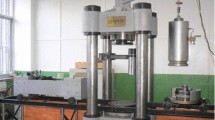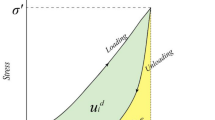Abstract
The fatigue test for rock salt is conducted under different stress amplitudes, loading frequencies, confining pressures and loading rates, from which the evaluation rule of the dissipated energy is revealed and analysed. The evolution of energy dissipation under fatigue loading is divided into three stages: the initial stage, the second stage and the acceleration stage. In the second stage, the energy dissipation per cycle remains stable and shows an exponential relation with the stress amplitude; the failure dissipated energy only depends on the mechanical behaviour of the rock salt and confining pressure, but it is immune to the loading conditions. The energy dissipation of fatigued rock salt is discussed, and a novel model for fatigue life prediction is proposed on the basis of energy dissipation. A simple model for evolution of the accumulative dissipated energy is established. Its prediction results are compared with the test results, and the proposed model is validated.











Similar content being viewed by others
Abbreviations
- E o :
-
Total dissipated energy
- E d :
-
Energy dissipated by storage wall damage
- E h :
-
Heat energy mainly dissipated by chemistry, conduction and radiation
- W id :
-
Dissipated energy of cycle i
- ɛ i :
-
Strain amplitude of cycle i
- A :
-
Stress amplitude
- W id :
-
Dissipated energy of cycle i
- \(W_{\text{d}}^{{i{ + }1}}\) :
-
Dissipated energy of cycle i + 1
- DER:
-
Dissipated energy ratio
- w d :
-
Stable energy dissipation per cycle
- μ :
-
Loading rate
- v :
-
Loading frequency
- a, b and c :
-
Curve-fitting parameters for the rock salt wd curve
- N :
-
Cycle number
- N f :
-
Fatigue life
- W f :
-
Accumulative dissipated energy when the specimen fractures
- ξ :
-
Material constant \(\xi = \frac{{w_{\text{d}} N_{\text{f}} }}{{W_{\text{f}} }}\)
- W 1f :
-
Accumulative dissipated energy at the initial stage of fatigue loading
- W 2f :
-
Accumulative dissipated energy at the second stage of fatigue loading
- W 3f :
-
Accumulative dissipated energy at the acceleration stage of fatigue loading
References
Dattoma V, Giancane S (2013) Evaluation of energy of fatigue damage into GFRC through digital image correlation and thermography. Compos Part B Eng 47:283–289
Erarslan N (2016) Microstructural investigation of subcritical crack propagation and Fracture Process Zone (FPZ) by the reduction of rock fracture toughness under cyclic loading. Eng Geol 208(24):181–190
Ghuzlan KA, Carpenter SH (2006) Fatigue damage analysis in asphalt concrete mixtures using the dissipated energy approach. Can J Civ Eng 33(7):890–901
Guo YT, Yang CH, Mao HJ (2012) Mechanical properties of Jintan mine rock salt under complex stress paths. Int J Rock Mech Min Sci 56:54–61
Hakan A (2009) Percolation model for dilatancy-induced permeability of the excavation damaged zone in rock salt. Int J Rock Mech Min Sci 46:716–724
Kittitep F, Decho P (2010) Effects of cyclic loading on mechanical properties of Maha Sarakham salt. Eng Geol 112:43–52
Lee HJ, Daniel JS, Kim YR (2000) Continuum damage mechanics-based fatigue model of asphalt concrete. J Mater Civ Eng 12(2):105–112
Lei D, Zhao JH, Gong M, Yu DK (2008) On the energy dissipation in fatigue process and fatigue life prediction. J Exp Mech 5:008
Lei D, Zhang P, He JT, Bai PX, Zhu FP (2017) Fatigue life prediction method of concrete based on energy dissipation. Constr Build Mater 145:419–425
Liang WG, Zhao YS, Xu SG, Dusseault MB (2011) Effect of strain rate on the mechanical properties of salt rock. Int J Rock Mech Min Sci 48:161–167
Liang WG, Zhang CD, Gao HB, Yang XQ, Xu SG, Zhao YS (2012) Experiments on mechanical properties of salt rocks under cyclic loading. J Rock Mech Geotech Eng 4(1):54–61
Ma LJ, Wang MY, Zhang N, Fan PX, Li J (2017) A variable-parameter creep damage model incorporating the effects of loading frequency for rock salt and its application in a bedded storage cavern. Rock Mech Rock Eng (First Online: 05 June 2017)
Payten WM, Dean DW, Snowden KU (2010) A strain energy density method for the prediction of creep–fatigue damage in high temperature components. Mater Sci Eng A 527:1920–1925
Qian HT, Tan ZS, Li SD, Wang SJ (2010) Analysis of effect of stress on dissolution mechanism of salt rock. Chin J Rock Mech Eng 29(4):757–764
Roberts LA, Buchholz SA, Mellegard KD, Düsterloh U (2015) Cyclic loading effects on the creep and dilation of salt rock. Rock Mech Rock Eng 48(6):2581–2590
Shen SH, Airey GD, Carpenter SH, Hai H (2006) A dissipated energy approach to fatigue evaluation. Road Mater Pavement Des 7(1):47–69
Song R, Yueming B, JingPeng Z, Deyi J, Chunhe Y (2013) Experimental investigation of the fatigue properties of salt rock. Int J Rock Mech Min Sci 64:68–72
Tepfers R, Hedberg B, Szczekocki G (1984) Absorption of energy in fatigue loading of plain concrete. Matériaux et Construction 17(1):59–64
Wang RZ, Zhang XC, Tu ST, Zhu SP, Zhang CC (2016) A modified strain energy density exhaustion model for creep-fatigue life prediction. Int J Fatigue 90:12–22
Xiao L, Gu HC (1998) Plastic energy dissipation model for lifetime prediction of Zirconium and Zircaloy-4 fatigued at RT and 400 C. J Eng Mater T ASME 120(4):114–118
Xiao JQ, Ding DX, Gen X (2009) Inverted S-shaped model for nonlinear fatigue damage of rock. Int J Rock Mech Min Sci 46:643–648
Xiao JQ, Ding DX, Jiang FL, Gen X (2010) Fatigue damage variable and evolution of rock subjected to cyclic loading. Int J Rock Mech Min Sci 47:461–468
Xie HP, Peng RD, Ju Y (2004) Energy dissipation of rock deformation and fracture. Chin J Rock Mech Eng 23(21):3565–3570
Xie HP, Peng RD, Ju Y, Zhou HW (2005) On energy analysis of rock failure. Chin J Rock Mech Eng 24(15):2603–2608
Xie HP, Li LY, Ju Y, Peng RD, Yang YM (2011) Energy analysis for damage and catastrophic failure of rock. Sci China Technol Sci 54(S1):199–209
Acknowledgements
This study is sponsored by the National Natural Science Foundation of China (Nos. 51179153 and 11572246). The financial support provided by these sponsors is greatly appreciated.
Author information
Authors and Affiliations
Corresponding author
Rights and permissions
About this article
Cite this article
He, M., Huang, B., Zhu, C. et al. Energy Dissipation-Based Method for Fatigue Life Prediction of Rock Salt. Rock Mech Rock Eng 51, 1447–1455 (2018). https://doi.org/10.1007/s00603-018-1402-8
Received:
Accepted:
Published:
Issue Date:
DOI: https://doi.org/10.1007/s00603-018-1402-8




